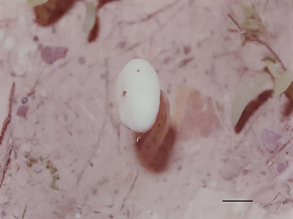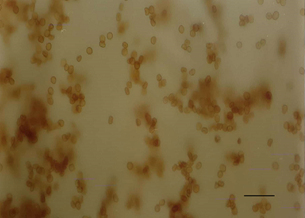Tulostoma brumale Pers., Neues Magazin für die Botanik 1: 86 (1794) Fig. 9
MycoBank number: MB 139867; Index Fungorum number: IF 139867; Facesoffungi number: FoF 09752;
Fruiting body –1.0–2.0 cm diameter, Stipe –length 2–4 × 2.5–1.0 cm diameter characterized by small, pale grey-brown , more or less rounded head surrounding a tough brown curved stipe, found in small trooping groups in sandy soil and on sand dunes. Peridium –sub-spherical with a small papillate projection, ostiole in the centre of the sub-globose head.Exoperidium –vanishing, soon exposing papery endoperidium. Gleba– at first white and firm, soon becoming brown, turning to a powdery mass of spores which are released from the ostiole. Spores –yellowish-brown, smooth to finely warty, globose, 3.5–5.0 µm, epispore somewhat dark ferruginous.
Ecology and distribution–Karadelev & Rusevska (2009) reported Tulostoma brumale from Republic of Macedonia as a psammophilous or humicolous species and in areas with vegetation protection, or on sandy soils amongst herbs and mosses, either solitary or in large numbers. According to Jeppson et al. (2017), this species occurs in all types of sandy and calcareous grasslands, sand dunes and steppe vegetation, as well as on moss covered rocks and stone walls in the dry, arid areas of southern and east central Europe.
Specimens examined – JNV/Mycl/128 on 22 July 2019 in zone IA and IIB in sandy soil, collected by Reenu Chouhan. 25°45’0.00″N 71°22’48.00″E Barmer,elevation:227 m (745 ft), 28°01’3.43″N73°18’53.82″E Bikaner, elevation:242 m (794 ft), 26°55’3.47″N70°54’13.93″E Jaisalmer, elevation: 225 m (738 ft), 28°18’0.00″N74°57’0.00″E Churu, elevation:292 m (958 ft), 26°16’6.28″N73°00’21.38″E Jodhpur, elevation:231 m (758 ft), 25°20’44.09″N72°36’56.12″E Jalore, elevation:178 m (584 ft), 25°46’12.00″N73°19’48.00″E Pali, elevation: 214 m (702 ft), 24°53’18.17″N72°50’52.58″E Sirohi, elevation:321 m (1,053 ft).
Note – The taxonomic description of this species has been given by Wright (1987) and by Doshi& Sharma (1997) from Rajasthan. According to Dutta et al. (2020), Tulostoma brumale is morphologically related taxa of Tulostoma squamosum. Accordingly, T. brumale has light brownish to cinereous brown exoperidium, shorter stalks measuring 14–45 × 1.5–4.0 mm, coloured straw yellow and has smaller spores with a mean diameter of 5μm when compared to the greyish-orange thin exoperidium. This species has a larger size of stalk and comparatively larger spores of size 6.5–7.2 μm of T. squamosum.

a

b
Fig. 9–a Fruiting body of Tulostoma brumale on dry, sandy soil. b.Spores. Scale bar: a = 5 cm,
b = 20 µm.
